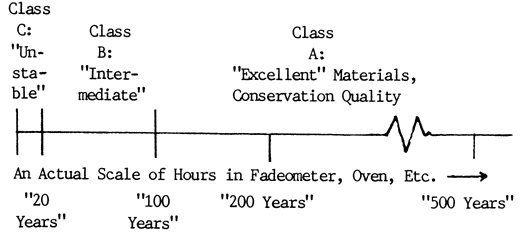

A three-year study at the Mellon Institute funded by the Getty Conservation Institute has concerned itself with the aging characteristics of five types of cellulose ethers used in conservation: carboxymethylcellulose (CMC), methyl-cellulose (MC), ethylcellulose (EC), ethylhydroxyethylcellulose (EHEC) and hydroxypropylcellulose (HPC). Their stability was tested by means of heat, light, aqueous acids, and bases; heat aging was done at 90°C. Samples were prepared as powders and as films--with and without a backing material--and subjected to controlled exposures of heat and light. At selected intervals during the experiment, samples were removed and tested for changes in polymer chain length, weight loss, embrittlement, discoloration, peroxide formation, and decreases in solubility. On the basis of these and other tests, the lab concluded that the stability of the ethers can be ranked in decreasing order of stability as follows: 1) CMC 2) MC and water-soluble EHEC; and 3) HPC. Ethyl cellulose, the remaining type, is unstable and is not recommended for conservation use, but no one is known to be using it for this purpose in any case.
These results suggest that the HPC type (Klucel G and other proprietary brands) deserves further consideration with regard to its applications, and additional studies on this matter are in progress.
The report can be ordered from J. Paul Getty Trust Publications, Book Warehouse, J. Paul Getty Museum, PO Box 2112, Santa Monica, CA 90406, for $8 + $2 shipping and handling. The reference is: "Evaluation of Cellulose Ethers for Conservation" (Research in Conservation #3), by M. Wilt and R. L. Feller. Publication is planned for later this year.
Book conservators have found HPC to be handy for consolidating weak and powdery leather covers, because it cam be dissolved in alcohol and does not shrink or blacken the leather as water does. It appears to fall in the "intermediate" classification (a projected lifetime of 20-100 years) for conservation materials, which was proposed some years ago by the same lab, and which is described in "Some factors to be Considered in Accelerated-Aging Tests," by Robert Feller (AIC Preprints, 1987, p. 56-67). It is diagrammed like this:

The author says, "A challenging question facing the field of conservation science is what to do with the materials that seem to fall in the intermediate class as the result of accelerated-aging tests. There are a great many materials that the conservator finds very attractive from the point of view of ease of handling and yet which have properties that are noticeably less stable than those of what we may choose to call Class A materials. So far, the Research Center at Mellon Institute has devoted very little attention to such materials, bet many of them might prove interesting and entirely suitable for conservation uses.... What is the limit of acceptable lifetime and acceptable decline in properties for materials to be used in long-term contact with the artifacts we wish to preserve? Thus far there has been little discussion of this matter in the conservation field."
Fig. 4. Useful lifetimes of materials as crudely estimated on the basis of accelerated-aging tests